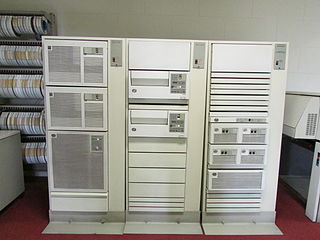Related Research Articles
IBM mainframes are large computer systems produced by IBM since 1952. During the 1960s and 1970s, IBM dominated the computer market with the 7000 series and the later System/360, followed by the System/370. Current mainframe computers in IBM's line of business computers are developments of the basic design of the System/360.

Multiple Virtual Storage, more commonly called MVS, is the most commonly used operating system on the System/370, System/390 and IBM Z IBM mainframe computers. IBM developed MVS, along with OS/VS1 and SVS, as a successor to OS/360. It is unrelated to IBM's other mainframe operating system lines, e.g., VSE, VM, TPF.

A mainframe computer, informally called a mainframe or big iron, is a computer used primarily by large organizations for critical applications like bulk data processing for tasks such as censuses, industry and consumer statistics, enterprise resource planning, and large-scale transaction processing. A mainframe computer is large but not as large as a supercomputer and has more processing power than some other classes of computers, such as minicomputers, servers, workstations, and personal computers. Most large-scale computer-system architectures were established in the 1960s, but they continue to evolve. Mainframe computers are often used as servers.

Transaction Processing Facility (TPF) is an IBM real-time operating system for mainframe computers descended from the IBM System/360 family, including zSeries and System z9.

z/OS is a 64-bit operating system for IBM z/Architecture mainframes, introduced by IBM in October 2000. It derives from and is the successor to OS/390, which in turn was preceded by a string of MVS versions. Like OS/390, z/OS combines a number of formerly separate, related products, some of which are still optional. z/OS has the attributes of modern operating systems but also retains much of the older functionality that originated in the 1960s and is still in regular use—z/OS is designed for backward compatibility.

VM is a family of IBM virtual machine operating systems used on IBM mainframes System/370, System/390, zSeries, System z and compatible systems, including the Hercules emulator for personal computers.
IBM CICS is a family of mixed-language application servers that provide online transaction management and connectivity for applications on IBM mainframe systems under z/OS and z/VSE.

IBM Airline Control Program, or ACP, is a discontinued operating system developed by IBM beginning about 1965. In contrast to previous airline transaction processing systems, the most notable aspect of ACP is that it was designed to run on most models of the IBM System/360 mainframe computer family. This departed from the earlier model in which each airline had a different, machine-specific transaction system.
Sabre Global Distribution System, owned by Sabre Corporation, is a travel reservation system used by travel agents and companies to search, price, book, and ticket travel services provided by airlines, hotels, car rental companies, rail providers and tour operators. Originally developed by American Airlines under CEO C.R. Smith with the assistance of IBM in 1960, the booking service became available for use by external travel agents in 1976 and became independent of the airline in March 2000.
Sabre Corporation, a travel technology company headquartered in Southlake, Texas, is the largest global distribution systems (GDS) provider for air bookings. The company's primary product, the Sabre Global Distribution System, and others like it, act as neutral intermediaries, connecting travel suppliers like airlines and hotels with travel sellers like agencies. They offer real-time availability and pricing, making them important for corporate travel management.
In computing, a Parallel Sysplex is a cluster of IBM mainframes acting together as a single system image with z/OS. Used for disaster recovery, Parallel Sysplex combines data sharing and parallel computing to allow a cluster of up to 32 systems to share a workload for high performance and high availability.
ALCS, which stands for Airline Control System, is an application server that provides industrial-strength, online transaction management for mission-critical applications.
A transaction processing system (TPS) is a software system, or software/hardware combination, that supports transaction processing.
QIK is an intelligent airline agent application first developed in the late 1980s as a front end to mainframe computer reservations systems.

Operating System/Virtual Storage 1, or OS/VS1, is a discontinued IBM mainframe computer operating system designed to be run on IBM System/370 hardware. It was the successor to the Multiprogramming with a Fixed number of Tasks (MFT) option of System/360's operating system OS/360. OS/VS1, in comparison to its predecessor, supported virtual memory. OS/VS1 was generally available during the 1970s and 1980s, and it is no longer supported by IBM.
The history of IBM mainframe operating systems is significant within the history of mainframe operating systems, because of IBM's long-standing position as the world's largest hardware supplier of mainframe computers. IBM mainframes run operating systems supplied by IBM and by third parties.
A teleprocessing monitor is a control program that monitors the transfer of data between multiple local and remote terminals to ensure that the transaction processes completely or, if an error occurs, to take appropriate actions.
The Input/Output Configuration Program is a program on IBM mainframes.

The IBM 9370 systems are "baby mainframe" midrange computers, released 1986 at the very low end of, and compatible with System/370. The media of the day, referring to the VAX systems manufactured by Digital Equipment Corporation (DEC), carried IBM's alleged "VAX Killer" phrase, albeit often skeptically.
The IBM 3090 family is a family of mainframe computers that was a high-end successor to the IBM System/370 series, and thus indirectly the successor to the IBM System/360 launched 25 years earlier.
References
- ↑ MVS
- ↑ Sharma, Anurag (2024-10-08). "American Airlines Seeks $94 Million in Skiplagging Travel Hack Lawsuit". Aviation A2Z. Retrieved 2024-12-10.
- ↑ "Examples of IT Project failure". Archived from the original on 2010-03-30. Retrieved 2010-06-12.
- ↑ "THE STANDISH GROUP REPORT" (PDF). The Standish Group. 1995. Archived from the original (PDF) on 2011-07-21. Retrieved 12 June 2010.